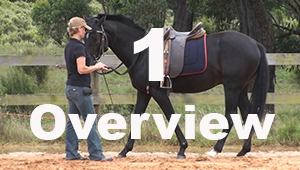
Stop and Back Up - Overview
In this video series you will learn how to get your horse to stop and back up from the ground.
Training Information
Suitable For: All horses (2 years +)
Videos in Course: 3
This course will show you how to teach your horse to stop and back up from the ground.
Purpose:
The purpose of the lesson is to teach the horse to back up from the rein. The lesson is taught on the ground from one side at a time and the horse will learn to back up on an angle, giving you hindquarter control off the rein later in the back up so that you can back in a straight line.
The Basic Lesson Elements:
The SPOT on the horse that you want to move: The left front foot
The DIRECTION you want it to go: Forwards and backwards
The MOTIVATION for moving it: Dressage whip tapping the hip, gentle rein or lead rope pressure
The REWARD given for the correct response: Release of pressure, praise and allow the horse to stand and rest
Prerequisites:
- Bridling and 'give to the bit'. It is important that the horse understands softness in the bridle and travelling in frame (give to the bit work) before teaching this lesson.
- The stops lesson should also have been taught as this series moves directly on from there.
ISES Training Principles:
- Release the pressure immediately when the horse responds. We are using rein pressure to teach the horse to back up and it must be released as soon as the horse moves back to make it clear that he gave the desired response.
- Use signals that the horse can differentiate. This rein signal will be different from a turn signal, for example, where the rein is moved away from the neck and the horse is cued to follow his nose.
- Train and initiate responses one at a time (shaping). We only ask for one step at a time and build on that.
- Train habitual responses using consistency and repetition. Be consistent in your pressure cues and the release of that pressure so that the horse learns the pattern - pressure is released when I step back.
- Train only one response per signal. The response we are targeting is backward movement of the feet.
- Avoid fear during training. Allow the horse time to learn the lesson and never push the horse backwards with the rein as this will fear in the horse (as a result of the pain caused by heavy pressure on the bit).
- Train persistence of responses. At the end of the lesson the horse should be backing until he is cued to do something else - stand or move forward.
- Check for relaxation. Be sure your horse is not displaying any conflict behaviours such as pinning his ears or throwing his head in order to optimize training and performance.
